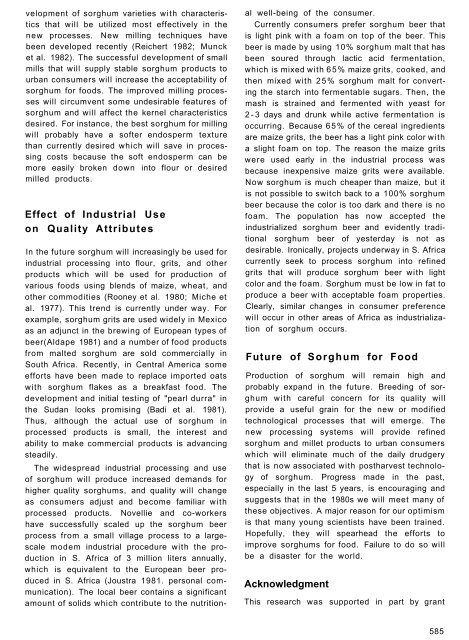RA 00048.pdf - OAR@ICRISAT
RA 00048.pdf - OAR@ICRISAT
RA 00048.pdf - OAR@ICRISAT
Create successful ePaper yourself
Turn your PDF publications into a flip-book with our unique Google optimized e-Paper software.
velopment of sorghum varieties with characteristics<br />
that will be utilized most effectively in the<br />
new processes. New milling techniques have<br />
been developed recently (Reichert 1982; Munck<br />
et al. 1982). The successful development of small<br />
mills that will supply stable sorghum products to<br />
urban consumers will increase the acceptability of<br />
sorghum for foods. The improved milling processes<br />
will circumvent some undesirable features of<br />
sorghum and will affect the kernel characteristics<br />
desired. For instance, the best sorghum for milling<br />
will probably have a softer endosperm texture<br />
than currently desired which will save in processing<br />
costs because the soft endosperm can be<br />
more easily broken down into flour or desired<br />
milled products.<br />
Effect of Industrial Use<br />
on Quality Attributes<br />
In the future sorghum will increasingly be used for<br />
industrial processing into flour, grits, and other<br />
products which will be used for production of<br />
various foods using blends of maize, wheat, and<br />
other commodities (Rooney et al. 1980; Miche et<br />
al. 1977). This trend is currently under way. For<br />
example, sorghum grits are used widely in Mexico<br />
as an adjunct in the brewing of European types of<br />
beer(Aldape 1981) and a number of food products<br />
from malted sorghum are sold commercially in<br />
South Africa. Recently, in Central America some<br />
efforts have been made to replace imported oats<br />
with sorghum flakes as a breakfast food. The<br />
development and initial testing of "pearl durra" in<br />
the Sudan looks promising (Badi et al. 1981).<br />
Thus, although the actual use of sorghum in<br />
processed products is small, the interest and<br />
ability to make commercial products is advancing<br />
steadily.<br />
The widespread industrial processing and use<br />
of sorghum will produce increased demands for<br />
higher quality sorghums, and quality will change<br />
as consumers adjust and become familiar with<br />
processed products. Novellie and co-workers<br />
have successfully scaled up the sorghum beer<br />
process from a small village process to a largescale<br />
modem industrial procedure with the production<br />
in S. Africa of 3 million liters annually,<br />
which is equivalent to the European beer produced<br />
in S. Africa (Joustra 1981. personal communication).<br />
The local beer contains a significant<br />
amount of solids which contribute to the nutritional<br />
well-being of the consumer.<br />
Currently consumers prefer sorghum beer that<br />
is light pink with a foam on top of the beer. This<br />
beer is made by using 10% sorghum malt that has<br />
been soured through lactic acid fermentation,<br />
which is mixed with 65% maize grits, cooked, and<br />
then mixed with 25% sorghum malt for converting<br />
the starch into fermentable sugars. Then, the<br />
mash is strained and fermented with yeast for<br />
2 - 3 days and drunk while active fermentation is<br />
occurring. Because 65% of the cereal ingredients<br />
are maize grits, the beer has a light pink color with<br />
a slight foam on top. The reason the maize grits<br />
were used early in the industrial process was<br />
because inexpensive maize grits were available.<br />
Now sorghum is much cheaper than maize, but it<br />
is not possible to switch back to a 100% sorghum<br />
beer because the color is too dark and there is no<br />
foam. The population has now accepted the<br />
industrialized sorghum beer and evidently traditional<br />
sorghum beer of yesterday is not as<br />
desirable. Ironically, projects underway in S. Africa<br />
currently seek to process sorghum into refined<br />
grits that will produce sorghum beer with light<br />
color and the foam. Sorghum must be low in fat to<br />
produce a beer with acceptable foam properties.<br />
Clearly, similar changes in consumer preference<br />
will occur in other areas of Africa as industrialization<br />
of sorghum occurs.<br />
Future of Sorghum for Food<br />
Production of sorghum will remain high and<br />
probably expand in the future. Breeding of sorghum<br />
with careful concern for its quality will<br />
provide a useful grain for the new or modified<br />
technological processes that will emerge. The<br />
new processing systems will provide refined<br />
sorghum and millet products to urban consumers<br />
which will eliminate much of the daily drudgery<br />
that is now associated with postharvest technology<br />
of sorghum. Progress made in the past,<br />
especially in the last 5 years, is encouraging and<br />
suggests that in the 1980s we will meet many of<br />
these objectives. A major reason for our optimism<br />
is that many young scientists have been trained.<br />
Hopefully, they will spearhead the efforts to<br />
improve sorghums for food. Failure to do so will<br />
be a disaster for the world.<br />
Acknowledgment<br />
This research was supported in part by grant<br />
585

















